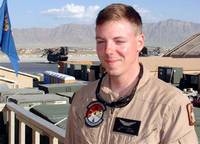| |

Courtesy of U.S. Army
Chief Warrant Officer 2 Joshua Howe of Company F, 159th Aviation Regiment — commonly known as “Big Windy” — has made a habit of narrowly escaping danger while racking up 470 combat flight hours.

Courtesy of U.S. Army
Chief Warrant Officer 2 Joshua Howe stands next to the Chinook that absorbed a rocket hit June 8 near Shkin, Afghanistan.
|
In his six years of flying Chinooks, Chief Warrant Officer 2 Justin Howe had never been through a landing quite like this.
He had just settled the big CH-47D transport helicopter from F Company, 159th Aviation Regiment — best known by its nickname, “Big Windy” — down on the gravel pad at Firebase Goodwin, in eastern Afghanistan, at 11 a.m. local time 8 June, bearing a load of cargo along with the five-man crew and 12 passengers.
With the engines still running, he glanced through his windshield and saw a flash in the distance. The boom followed moments later.
“I heard the bang in the back of the aircraft,” Howe, 28, of Punta Gorda, Fla., recalled Monday in a telephone interview from Afghanistan. “We hadn’t been on the ground two minutes.”
Howe and his crew didn’t yet know that insurgents had fired four rockets at the firebase. One of them narrowly missed his Chinook but struck squarely in the midst of the ground crew preparing to unload it.
The attack killed Pfc. Emmanuel Hernandez, 22, of the 173rd Airborne Brigade’s 319th Field Artillery Battalion, and Sgt. Michael J. Kelley, 26, of the Massachusetts National Guard’s 101st Field Artillery Battalion. Eight other soldiers suffered injuries.
At first, Howe didn’t realize how bad the blast was. For a moment he thought the flight engineers, Spc. Ryan Winter and Sgt. Jorge Goicochea, were banging around cargo in the back. But the noise, he said, seemed “five times louder” than usual.
But Howe and his co-pilot, 1st Lt. Matthew Gettings, quickly figured out they were being attacked. At first, they hoped to take off again — until the flight engineers told him the rear of the aircraft had been riddled with shrapnel. One piece had pierced the tank holding transmission fluid, leaving it in a sticky puddle on the ground.
“We had to shut the aircraft down pretty fast,” Howe said.
The rocket had struck just aft of the Chinook, but none of the shrapnel struck the passengers or crew. The engineers and the gunner, Pfc. Evan Templeton, hustled the riders out the right front door to safety.
“It was kind of chaos on the ground,” Howe said. “The landing zone at that point obviously wasn’t safe.”
After notifying his chain of command and checking on his passengers, Howe ran back to the landing zone to see if he could help.
Medics had loaded the dead and injured into Humvees and ferried them to the aid station. He helped carry some oxygen tanks but soon realized the medics had enough help.
That afternoon, Howe said, his commander arrived to personally fly the Big Windy crew and passengers (including five airmen from the 386th Expeditionary Group, six soldiers, and one civilian contractor) to their destinations.
With a yearlong tour of Iraq in 2003-04 behind them, wartime flying is nothing new to Big Windy or Howe. He had racked up 470 combat flight hours — 200 of them in the 3˝ months since the unit arrived in Afghanistan.
But he said the flying conditions are much harder this time. The high altitude, mountain peaks and bad weather make every flight in Afghanistan treacherous. On 6 April 2005, his Chinook and another one , 88-00100, were flying together when a sandstorm suddenly hit. Howe flew out of it safely but the other one crashed, killing all 18 passengers and crew.
“In Iraq, if you saw a shamal (sandstorm) coming, you just didn’t fly. Here, it might be in just one little valley,” he said. “It’s quite a dramatic and explosive environment here.”
But, Howe said, pilots don’t spend a lot of time dwelling on the dangers. He took just one day off after last week’s attack.
“There’s not a whole lot you can do,” he said. “The mission continues.” |

